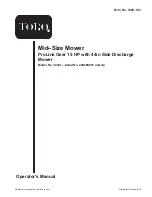
Brake Maintenance
Servicing the Brakes
Before each use, check brakes on both a level surface
and slope.
Always set the parking brake when you stop the machine
or leave it unattended. If the parking brake does not
hold securely, an adjustment is required.
Checking the Brakes
1. Park the machine on a level surface, disengage the
blade control (PTO).
2. Stop the engine, remove the key, and wait for all
moving parts to stop before leaving the operating
position.
3. Apply the parking brake. The wheels must lock
when you try to push the machine forward.
4. If the wheels do not lock, adjust the brakes. Refer
to Adjusting the Brakes.
5. Release the brake and press upper control bar very
lightly, approximately 1/2 inch (13 mm). The wheels
should rotate freely, if not; refer to Adjusting the
Brakes.
Adjusting the Brakes
The brake lever is on the upper control bar. If the
parking brake does not hold securely, an adjustment is
required.
1. Park the machine on a level surface, disengage the
PTO, and set the parking brake.
2. Stop the engine, remove the key, and wait for all
moving parts to stop before leaving the operating
position.
3. Check the brake before you adjust it; refer to
Checking the Brakes.
4. Release the parking brake; refer to Releasing the
Parking Brake in Operation , page 13.
5. To adjust the brake, rotate the wing nuts on the
brake rods (Figure 35). Turn the wing nuts clockwise
to tighten the brake and counterclockwise to loosen
the brake.
Figure 35
1.
Brake rod
2.
Wing nut
Note:
Control bar should be parallel with the
reference bar when properly adjusted.
6. Check the brake operation again; refer to Checking
the Brakes.
Important:
With the parking brake released,
the rear wheels must rotate freely when you
push the mower. If brake action and free wheel
rotation cannot be achieved contact your service
dealer immediately.
32
Summary of Contents for 39696
Page 6: ...Slope Chart 6...













































